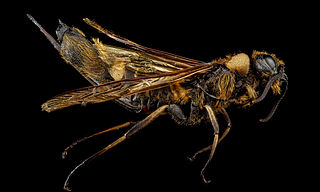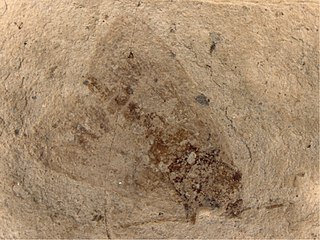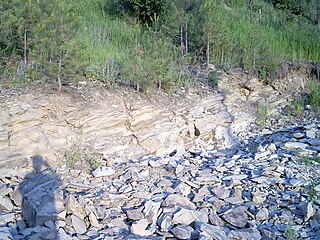
Horntail or wood wasp is the common name for any of the 150 non-social species of the family Siricidae, of the order Hymenoptera, a type of xylophagous sawfly. This family was formerly believed to be the sole living representative of the superfamily Siricoidea, a group well represented in Paleogene and Mesozoic times, but the family Anaxyelidae has been linked to this group as well. Siricidae has two sub families, Siricinae and Tremecinae. Siricinae infest needle-leaved trees and Tremecinae infest broad-leaved trees. There are ten living genera placed in the family, and an additional three genera described from fossils. The last tergite of the abdomen has a strong, projecting spike, thus giving the group its common name. A typical adult horntail is brown, blue, or black with yellow parts, and may often reach up to 4 cm (1.6 in) long. The pigeon horntail can grow up to 5 cm (2.0 in) long, among the longest of all Hymenoptera.
Driftwood Canyon Provincial Park is a provincial park in British Columbia, Canada. Driftwood Canyon Provincial Park covers 23 ha of the Bulkley River Valley, on the east side of Driftwood Creek, a tributary of the Bulkley River, 10 km northeast of the town of Smithers. The park is accessible from Driftwood Road from Provincial Highway 16. It was created in 1967 by the donation of the land by the late Gordon Harvey (1913–1976) to protect fossil beds on the east side of Driftwood Creek. The beds were discovered around the beginning of the 20th century. The park lands are part of the asserted traditional territory of the Wet'suwet'en First Nation.

Pamphiliidae is a small wasp family within Symphyta, containing some 200 species from the temperate regions of North America and Eurasia. The larvae feed on plants, using silk to build webs or tents, or to roll leaves into tubes in which they feed, thus earning them the common names leaf-rolling sawflies or web-spinning sawflies. Some species are gregarious and the larvae live in large groups. Fossils of Pamphiliidae have been dated to the Jurassic period.
Ulteramus is an extinct genus of parasitic wasp in the sawfly family Pamphiliidae. The genus is solely known from an Eocene fossil found in North America. At the time of its description the new genus was composed of a single species, Ulteramus republicensis.

Dinokanaga is a small genus of scorpionfly belonging to the extinct family Dinopanorpidae. The six species D. andersoni, D. dowsonae, D. hillsi, D. sternbergi, D. webbi, and D. wilsoni have all been recovered from Eocene fossil sites in British Columbia, Canada, and Washington state, United States.

Dillhoffia is an extinct monotypic genus of flowering plant with a single species, Dillhoffia cachensis known from Ypresian age Eocene fossils found in British Columbia, Canada, and Washington, USA. The genus and species were described from fifteen specimens found in an unnamed formation belonging to the Kamloops group shales; and two specimens from the Klondike Mountain Formation. The unnamed formation outcrops at the McAbee Fossil Beds near Cache Creek, BC, which is designated the type locality while the two U.S. specimens were recovered from the Tom Thumb Tuff member of the Klondike Mountain Formation in Republic, Washington. It is of interest to note that of the Okanagan highlands fossil sites Dillhoffia is only known from two locations, and is absent or has not been identified from the others.
Pseudosiobla campbelli is an extinct species of sawfly in the family Tenthredinidae that is known from early Eocene Ypresian stage lake deposits near the unincorporated community of Horsefly, British Columbia.

Paleolepidopterites is an extinct genus of moths from the family Tortricidae which are known from fossils found in Russia and the United States. The genus contains three species Paleolepidopterites destructus, Paleolepidopterites florissantanus, and Paleolepidopterites sadilenkoi, which were originally placed within the genera Tortrix and Tortricites respectively. The three species were formally redescribed in 2018.

The Klondike Mountain Formation is an Early Eocene (Ypresian) geological formation located in the northeast central area of Washington state. The formation, named for the type location designated in 1962, Klondike Mountain north of Republic, Washington, is composed of volcanic rocks in the upper unit and volcanics plus lacustrine (lakebed) sedimentation in which a lagerstätte with exceptionally well-preserved plant and insect fossils has been found, along with fossil epithermal hot springs.

Ypresiomyrma is an extinct genus of ants in the subfamily Myrmeciinae that was described in 2006. There are four species described; one species is from the Isle of Fur in Denmark, two are from the McAbee Fossil Beds in British Columbia, Canada, and the fourth from the Bol’shaya Svetlovodnaya fossil site in Russia. The queens of this genus are large, the mandibles are elongated and the eyes are well developed; a stinger is also present. The behaviour of these ants would have been similar to that of extant Myrmeciinae ants, such as solitary foraging for arthropod prey and never leaving pheromone trails. The alates were poor flyers due to their size, and birds and animals most likely preyed on these ants. Ypresiomyrma is not assigned to any tribe, and is instead generally regarded as incertae sedis within Myrmeciinae. However, some authors believe Ypresiomyrma should be assigned as incertae sedis within Formicidae.
Avitomyrmex is an extinct genus of bulldog ants in the subfamily Myrmeciinae which contains three described species. The genus was described in 2006 from Ypresian stage deposits of British Columbia, Canada. Almost all the specimens collected are queens, with an exception of a single fossilised worker. These ants are large, and the eyes are also large and well developed; a sting is present in one species. The behaviour of these ants may have been similar to extant Myrmeciinae ants, such as foraging solitarily for arthropod prey and never leaving pheromone trails to food sources. Avitomyrmex has not been assigned to any tribe, instead generally being regarded as incertae sedis within Myrmeciinae. However, its identity as an ant has been challenged, although it is undoubtedly a hymenopteran insect.

Macabeemyrma is an extinct genus of bulldog ants in the subfamily Myrmeciinae containing the single species Macabeemyrma ovata, described in 2006 from Ypresian stage deposits of British Columbia, Canada. Only a single specimen is known; a holotype queen found preserved as a compression fossil. The specimen had no wings and small portions of its legs and eyes were faintly preserved. It was a large ant, reaching 25 millimetres (0.98 in) in length. This ants' behaviour would have been similar to that of extant Myrmeciinae ants, such as foraging singly in search for arthropod prey and nesting in soil or in trees. Macabeemyrma shows similarities to extinct ants in the genus Ypresiomyrma, and to the living Nothomyrmecia macrops, but has not been conclusively assigned to any tribe, instead generally regarded as incertae sedis within Myrmeciinae. However, the sole specimen lacks definitive traits, and its classification in Myrmeciinae, and even its identity as an ant, has been challenged.

Myrmeciites is an extinct form genus of bulldog ants in the subfamily Myrmeciinae of the family Formicidae, which contains three described species and two fossils not placed beyond the genus level. Described in 2006 from Ypresian stage deposits, all three of the described species and one unplaced fossil are from British Columbia, Canada, while the second unplaced fossil is from Washington State, USA. These ants were large, with the largest specimens collected reaching 3 centimetres (1.2 in). The behaviour of these ants would have been similar to extant Myrmeciinae ants, such as solitary foraging, nesting either in the soil or trees, and leaving no pheromone trail to food sources. Due to the poor preservation of these ants, their phylogenetic position among Myrmeciinae is unclear, and no type species has been designated. These ants are classified as incertae sedis in Myrmeciinae, but some writers have classified it as incertae sedis within the insect order Hymenoptera. This reclassification, however, has not been accepted; instead, Myrmeciites remains in Myrmeciinae.
Acer rousei is an extinct maple species in the family Sapindaceae described from a series of isolated fossil samaras. The species is solely known from the Early Eocene sediments exposed in south central British Columbia, Canada adjacent to northeast Washington state in the United States. It is the type species for the extinct monotypic section Rousea.

The McAbee Fossil Beds is a Heritage Site that protects an Eocene Epoch fossil locality east of Cache Creek, British Columbia, Canada, just north of and visible from Provincial Highway 97 / the Trans-Canada Highway. The McAbee Fossil Beds, comprising 548.23 hectares, were officially designated a Provincial Heritage Site under British Columbia's Heritage Conservation Act on July 19, 2012. The site is part of an old lake bed which was deposited about 52 million years ago and is internationally recognised for the diversity of plant, insect, and fish fossils found there. Similar fossil beds in Eocene lake sediments, also known for their well preserved plant, insect and fish fossils, are found at Driftwood Canyon Provincial Park near Smithers in northern British Columbia, on the Horsefly River near Quesnel in central British Columbia, and at Republic in Washington, United States. The Princeton Chert fossil beds in southern British Columbia are also Eocene, but primarily preserve an aquatic plant community. A recent review of the early Eocene fossil sites from the interior of British Columbia discusses the history of paleobotanical research at McAbee, the Princeton Chert, Driftwood Canyon, and related Eocene fossil sites such as at Republic.

The Allenby formation is a sedimentary rock formation deposited during the early to early Middle Eocene. It consists of conglomerates, sandstones with interbedded with shales and coal. The coal seams contain an abundance of insect, fish and plant fossils, known from the shales since 1877 but best known from the Princeton Chert.

The Coldwater Beds are a geologic formation of the Okanagan Highlands in British Columbia, Canada. They preserve fossils dating back to the Ypresian stage of the Eocene period, or Wasatchian in the NALMA classification.
Eoprephasma is an extinct genus of stick insect in the superfamily Susumanioidea known from a group of Eocene fossils found in North America. When first described there was a single named species, E. hichensi.

Eorpidae is a small family of extinct insects in the scorpionfly order, Mecoptera, which contains a single genus, Eorpa. Three Eocene age species found in Western North America have been placed into the genus: E. elverumi, E. jurgeni, and E. ypsipeda.
Cuspilongus is an extinct genus of parasitic wasp in the sawfly family Cephidae. At the time of its description the new genus comprised a single species named Cuspilongus cachecreekensis, known from an Eocene fossil found in North America. Subsequently, Kopylov & Rasnitsyn (2016) transferred the Early Cretaceous (Aptian) species Mesocephus ghilarovi Rasnitsyn (1988), known from the Bon-Tsagan locality in Mongolia, to the genus Cuspilongus as well.











